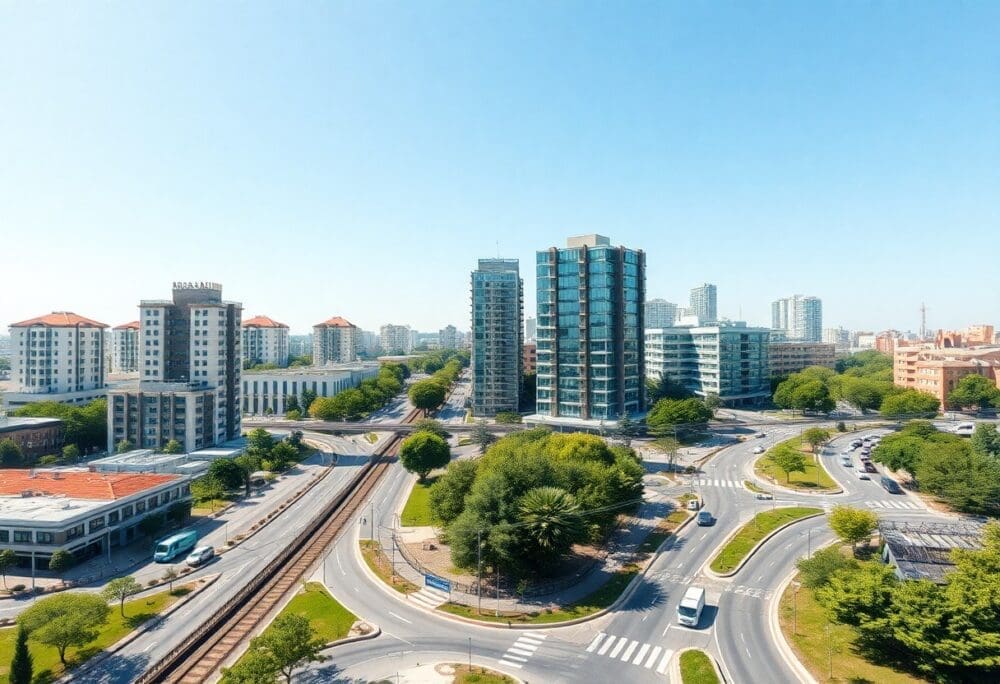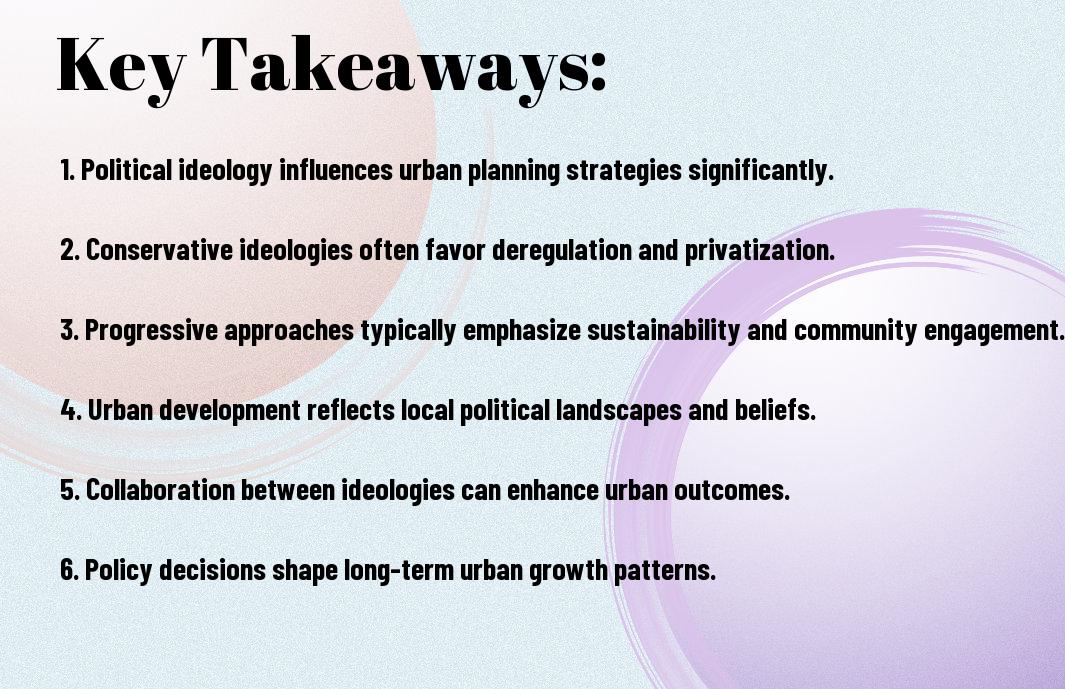Politics significantly shapes urban development strategies, influencing how cities grow and evolve. As you explore the intersection of political ideology and urban planning, you may find that differing viewpoints lead to distinct approaches in addressing housing, infrastructure, and sustainability. This post examines into the varying ideologies at play and examines how they manifest in urban development practices, offering insights into why certain cities adopt specific methods over others. By understanding these correlations, you can gain a deeper appreciation of the complexities involved in shaping urban environments.
Key Takeaways:
- Political ideology influences urban development policies, with progressive ideologies generally favoring sustainability and social equity while conservative approaches often prioritize economic growth and deregulation.
- Urban development strategies can reflect the ideological leanings of local governments, leading to divergent approaches in areas such as zoning laws, transportation initiatives, and affordable housing projects.
- Collaboration across political lines is crucial for addressing complex urban issues, as both ideological perspectives can bring valuable insights to the sustainable development discourse.
Understanding Political Ideology
While exploring political ideology, it becomes necessary to recognize how it shapes individuals’ beliefs, values, and priorities. Political ideology is a framework through which you interpret societal issues, guiding your stance on various topics such as governance, social justice, and economic policies. Understanding this concept allows you to critically evaluate how these ideologies influence significant aspects of urban development.
Definitions and Key Concepts
For a comprehensive grasp of political ideology, it’s important to identify key terms. Political ideology encompasses a set of principles that explains your beliefs regarding governance and social organization. It includes concepts like liberalism, conservatism, socialism, and libertarianism, each representing different perspectives on the role of government and individual freedoms.
Spectrum of Political Beliefs
Around the world, political beliefs exist on a spectrum, ranging from left to right. This spectrum illustrates a diversity of ideologies, where leftist beliefs typically emphasize collective responsibility and social equity, while rightist ideologies focus on individualism and market-oriented solutions. Your placement on this spectrum can significantly influence your views on urban development and policy decisions.
Ideology plays a fundamental role in shaping not just your political views but also your expectations for urban development. Those leaning left might advocate for comprehensive public services and sustainable practices within urban planning, promoting inclusivity and accessibility. In contrast, individuals aligned with right-leaning ideologies may emphasize market-driven approaches and reduced government intervention, favoring private sector solutions for urban issues. Understanding where you fall on this spectrum can illuminate your perspective on urban development strategies and the potential impacts they may have on your community.
Urban Development Approaches
Any exploration of urban development approaches reveals significant themes and methodologies shaping cities worldwide. You can investigate deeper into neoliberal urban development and the polarization of …, which illustrates how different ideologies influence planning and policy decisions.
Definition and Scope
Beside understanding the nuances of urban development, it is necessary to identify its various dimensions including economic, social, and environmental factors. These aspects collectively shape the landscape and cultural fabric of urban areas, allowing for diverse methodologies to emerge.
Conventional vs. Progressive Methods
Before delving into urban methodologies, it’s vital to recognize the dichotomy between conventional and progressive methods. Conventional methods often focus on economic growth and maximizing profit, while progressive methods prioritize social equity, environmental sustainability, and community involvement.
In fact, the distinction between conventional and progressive urban development methods can significantly influence the quality of life in communities. Conventional methods typically prioritize short-term economic benefits, often leading to gentrification and displacement. On the other hand, progressive methods encourage participatory planning, emphasizing the importance of community input and addressing social inequalities. By understanding these approaches, you can better grasp how political ideologies shape urban spaces and the lives of residents within them.
Historical Context of Urban Development
Your understanding of urban development is rooted in a rich historical context that has evolved alongside various social, economic, and political changes. Cities have been shaped by industrialization, globalization, and demographic shifts, each period reflecting the prevailing ideologies of the time. From the grid systems of Enlightenment-era planning to the garden cities of the early 20th century, urban spaces have continuously transformed, often mirroring the overarching political frameworks that guided governance and civic priorities.
Political Influences in Urban Planning
Around the world, urban planning has been significantly influenced by political ideologies and governance structures. The allocation of resources, the prioritization of public versus private interests, and the implementation of zoning laws often reflect the priorities of those in power, whether they advocate for capitalist development, socialist principles, or environmental sustainability.
Case Studies of Ideologically Driven Urban Policies
Case studies illustrate how different ideologies manifest in urban policies and their outcomes. These examples reflect the intersection of political beliefs and urban development:
- 1. New Urbanism (USA): Advocated for walkable neighborhoods; cities like Seaside, FL report increased property values by over 40% since redevelopment.
- 2. Danish Approach to Green Cities (Denmark): Copenhagen’s commitment to sustainability has led to plans for cycling infrastructure, aiming for a 50% increase in cyclists by 2025.
- 3. Social Housing Initiatives (Vienna, Austria): 60% of residents live in subsidized housing, making it one of the most affordable cities in Europe.
- 4. Gentrification Policies (Brooklyn, NY): Ongoing urban renewal has led to a decrease in affordable housing options, with some neighborhoods seeing rent increases of 200% within a decade.
- 5. Smart City Initiatives (Singapore): Investments in technology aim to improve urban living efficiency; the government projects a 30% increase in energy efficiency by 2030.
Indeed, examining these case studies provides insights into the consequences of ideologically driven urban policies. By analyzing the outcomes of specific initiatives, you can see how political ideologies translate into tangible urban results, shaping the quality of life, economic opportunities, and environmental sustainability in various communities. Understanding these dynamics can inform your perspective on future urban challenges and solutions.
Current Trends in Urban Development
Despite ongoing debates about the intersection of political ideology and urban development, current trends emphasize sustainability, smart technology integration, and inclusive community engagement. Many cities are now prioritizing green spaces, mixed-use developments, and transportation alternatives that reflect a growing awareness of environmental challenges. You may notice that urban planners increasingly collaborate with various stakeholders, demonstrating that urban development is shaping spaces for diverse communities and responding to the needs of today’s urban dweller.
Analysis of Recent Urban Projects
Current urban projects showcase a shift towards adaptive reuse and revitalization, reflecting a growing emphasis on sustainability. You might observe that many cities are transforming historical buildings into modern spaces, contributing to a sense of place while addressing contemporary needs. These initiatives not only enhance the urban landscape but also encourage local economic growth and community cohesion.
Role of Local Governments and Policy Makers
About local governments and policy makers, they play a significant role in shaping urban development strategies that reflect community values and needs. You will find that engaged officials often lead to innovative projects that align with the political ideologies of the region, demonstrating how governance influences urban outcomes.
Role of local governments and policy makers extends beyond project approvals; they set the framework for community involvement and prioritize funding for vital services. By championing policies that favor sustainable development, they impact the long-term viability of urban areas. Engaging with residents through public forums can help ensure that development initiatives align with the community’s aspirations, ultimately creating better urban environments that reflect the collective will.
Correlation Analysis
Unlike the common belief that urban development is solely based on economic factors, there is growing evidence suggesting a significant correlation between political ideology and urban development approaches. Various studies indicate these ideologies shape policy decisions, funding priorities, and community engagement in the planning process. By understanding these correlations, you can better navigate the complexities of urban development in relation to political landscape.
Examining Patterns Between Ideology and Development
By observing the alignment between political parties and their urban development strategies, you can pinpoint patterns that influence regional growth. For instance, progressive administrations often promote sustainable developments, while conservative leadership tends to support business-oriented projects. This alignment affects zoning laws, public housing initiatives, and transportation policies.
Statistical Studies on Urban Growth Factors
Growth in urban areas is often analyzed through statistical methods to understand various influencing factors. Recent studies have highlighted the connection between political ideology and urban growth by examining factors such as funding allocations and regulatory frameworks. Some key findings include:
- Progressive ideologies often lead to higher investments in public transport.
- Conservative approaches tend to focus on deregulation, impacting housing markets.
- The relationship between community engagement levels and urban project approvals varies significantly between ideological divides.
This analysis is important for comprehending the broader implications of development strategies you might encounter.
Consequently, as you explore deeper into the statistical studies surrounding urban growth, it becomes evident that political ideologies not only shape policy but also affect socio-economic outcomes. These outcomes can vary significantly based on leadership priorities and community input. Key insights from established research highlight:
- Comparative growth rates in urban areas influenced by differing political climates.
- Factors leading to sustainable growth versus rapid development concerns.
- The impact of federal and state policies on local development initiatives.
This understanding can empower you to advocate for more equitable urban growth strategies.
Implications for Future Urban Planning
Now, understanding the link between political ideology and urban development can significantly shape your approach to future urban planning. You can draw insights from various ideologies to create balanced cities that reflect diverse community needs. This awareness encourages you to question existing practices and consider innovative solutions that can enhance urban living for all citizens.
The Role of Ideology in Shaping Cities
Along the continuum of political ideologies, the development strategies employed in urban settings vary greatly. Your perspective on governance influences not only the physical landscape of cities but also impacts social equity and community engagement. Recognizing these ideological underpinnings aids you in interpreting existing urban dynamics and shapes your vision for future initiatives.
Recommendations for Inclusive Development
By prioritizing inclusive development strategies, you can foster urban environments that cater to the diverse needs of your community. It’s important to involve various stakeholders in the decision-making process, ensuring balanced representation in urban policy design and implementation.
With a focus on inclusivity, you can implement development projects that serve all demographics in your community. Engage with residents, local businesses, and advocacy groups to understand their needs and aspirations. Consider diverse perspectives in your urban planning initiatives, from affordable housing to accessible public spaces. By broadening participation in the planning process, you enhance social cohesion and create vibrant cities that reflect the rich tapestry of human experiences. This collaborative approach will help you develop sustainable urban environments where everyone feels valued and included.
Final Words
To wrap up, understanding the correlation between political ideology and urban development approaches enhances your awareness of how decisions shape your community. You may find that left-leaning ideologies often prioritize social equity and community engagement, while right-leaning perspectives might focus on economic growth and private investment. By recognizing these patterns, you can critically assess local development initiatives and advocate for solutions that align with your values and the needs of your community. Your engagement in these discussions is vital to fostering urban environments that truly reflect diverse perspectives.
Q: Is there a significant difference in urban development approaches between liberal and conservative political ideologies?
A: Yes, there tends to be significant differences in urban development approaches that align with political ideologies. Generally, liberal political ideologies may emphasize sustainable development, affordable housing, and community involvement, often advocating for policies that prioritize social equity and environmental concerns. On the other hand, conservative ideologies may focus more on economic efficiency, property rights, and reduced government regulation, which can lead to development strategies that promote private investment and infrastructure expansion without as strong a focus on social equity. These differing values shape the priorities and methodologies employed in urban planning.
Q: How do urban development policies reflect the political climate in a region?
A: Urban development policies often reflect the prevailing political climate of a region, as policymakers typically align their initiatives with the ideologies of their constituents. In areas where liberal views dominate, there may be a push for policies aimed at social justice, such as inclusive zoning laws and investment in public transportation. Conversely, in regions with a conservative majority, urban policies may lean toward deregulation and incentives for private developers, which can result in a focus on economic growth and less government intervention. These dynamics demonstrate how political ideologies not only influence specific policy choices but also affect broader urban development patterns.
Q: What impact does the political landscape have on community involvement in urban planning initiatives?
A: The political landscape significantly impacts community involvement in urban planning initiatives. In communities aligned with liberal ideologies, there is usually a higher emphasis on participatory planning processes, encouraging citizen engagement and input to shape development outcomes. This approach aims to ensure the voices of marginalized groups are heard. In contrast, communities with a more conservative political landscape may prioritize efficiency and speed in the planning process, potentially limiting public involvement. This can result in top-down decision-making, where community concerns may not be adequately integrated into development projects. The level and nature of community involvement are therefore reflective of the underlying political ideology guiding urban planning efforts.






